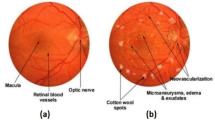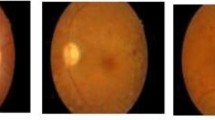Abstract
Diabetic retinopathy (DR) is one of the most common consequences of diabetes. It affects the retina, causing blood vessel damage which can lead to loss of vision. Saving patients from losing their sight or at least slowing the progress of this disease depends mainly on the early detection of this pathology, on top of the detection of its specific stage. Furthermore, the early detection of diabetic retinopathy and the follow-up of the patient’s condition remains an arduous task, whether for an experienced expert ophthalmologist or a computer-aided diagnosis technician. In this paper, we aim to propose a new automatic diabetic retinopathy severity level detection method. The proposed approach merges the pyramid hierarchy of the discrete wavelet transform of the retina fundus image with the modified capsule network and the modified inception block proposed, in addition to a new deep hybrid model that concatenates the inception block with capsule networks. The performance of our proposed approach has been validated on the APTOS dataset, as it achieved a high training accuracy of 97.71% and a high testing accuracy score of 86.54%, which is considered one of the best scores achieved in this field using the same dataset.








Similar content being viewed by others
Data Availability
The data we used in this work are available on the Kaggle platform.
References
Ana Rita Santos, Luísa Ribeiro, Francesco Bandello, Rosangela Lattanzio, Catherine Egan, Ulrik Frydkjaer-Olsen, José García-Arumí, Jonathan Gibson, Jakob Grauslund, Simon P Harding, et al. Functional and structural findings of neurodegeneration in early stages of diabetic retinopathy: cross-sectional analyses of baseline data of the eurocondor project. Diabetes, 66(9):2503–2510, 2017.
Diabetes Atlas. International diabetes federation. idf diabetes atlas, 9th edn. brussels. Belgium: 2019. Available at: https://www.diabetesatlas.org, Accessed: 17-nov-2020, 2019.
Sharon D Solomon, Emily Chew, Elia J Duh, Lucia Sobrin, Jennifer K Sun, Brian L VanderBeek, Charles C Wykoff, and Thomas W Gardner. Diabetic retinopathy: a position statement by the american diabetes association. Diabetes care, 40(3):412–418, 2017.
Pradeep Kumar Chaudhary and Ram Bilas Pachori. Automatic diagnosis of different grades of diabetic retinopathy and diabetic macular edema using 2-d-fbse-fawt. IEEE Transactions on Instrumentation and Measurement, 71:1–9, 2022.
Mohammed Oulhadj, Jamal Riffi, Khodriss Chaimae, Adnane Mohamed Mahraz, Bennis Ahmed, Ali Yahyaouy, Chraibi Fouad, Abdellaoui Meriem, Benatiya Andaloussi Idriss, and Hamid Tairi. Diabetic retinopathy prediction based on deep learning and deformable registration. Multimedia Tools and Applications, pages 1–19, 2022.
Ailiang Lin, Bingzhi Chen, Jiayu Xu, Zheng Zhang, Guangming Lu, and David Zhang. Ds-transunet: Dual swin transformer u-net for medical image segmentation. IEEE Transactions on Instrumentation and Measurement, 2022.
Yu Liu, Xun Chen, Aiping Liu, Rabab K Ward, and Z Jane Wang. Recent advances in sparse representation based medical image fusion. IEEE Instrumentation & Measurement Magazine, 24(2):45–53, 2021.
Rishab Gargeya and Theodore Leng. Automated identification of diabetic retinopathy using deep learning. Ophthalmology, 124(7):962–969, 2017.
Xianglong Zeng, Haiquan Chen, Yuan Luo, and Wenbin Ye. Automated diabetic retinopathy detection based on binocular siamese-like convolutional neural network. IEEE Access, 7:30744–30753, 2019.
Kedir M Adal, Peter G Van Etten, Jose P Martinez, Kenneth W Rouwen, Koenraad A Vermeer, and Lucas J van Vliet. An automated system for the detection and classification of retinal changes due to red lesions in longitudinal fundus images. IEEE Transactions on Biomedical Engineering, 65(6):1382–1390, 2017.
Anuj Jain, Arnav Jalui, Jahanvi Jasani, Yash Lahoti, and Ruhina Karani. Deep learning for detection and severity classification of diabetic retinopathy. In 2019 1st International Conference on Innovations in Information and Communication Technology (ICIICT), pages 1–6. IEEE, 2019.
Mohammad T Al-Antary and Yasmine Arafa. Multi-scale attention network for diabetic retinopathy classification. IEEE Access, 9:54190–54200, 2021.
Mihir Rao, Michelle Zhu, and Tianyang Wang. Conversion and implementation of state-of-the-art deep learning algorithms for the classification of diabetic retinopathy. arXiv preprint arXiv:2010.11692, 2020.
Jyostna Devi Bodapati, Nagur Shareef Shaik, and Veeranjaneyulu Naralasetti. Composite deep neural network with gated-attention mechanism for diabetic retinopathy severity classification. Journal of Ambient Intelligence and Humanized Computing, 12(10):9825–9839, 2021.
Venkatesulu Dondeti, Jyostna Devi Bodapati, Shaik Nagur Shareef, and Naralasetti Veeranjaneyulu. Deep convolution features in non-linear embedding space for fundus image classification. Rev. d’Intelligence Artif., 34(3):307–313, 2020.
Sharmin Majumder and Nasser Kehtarnavaz. Multitasking deep learning model for detection of five stages of diabetic retinopathy. IEEE Access, 9:123220–123230, 2021.
Sara Hosseinzadeh Kassani, Peyman Hosseinzadeh Kassani, Reza Khazaeinezhad, Michal J Wesolowski, Kevin A Schneider, and Ralph Deters. Diabetic retinopathy classification using a modified xception architecture. In 2019 IEEE international symposium on signal processing and information technology (ISSPIT), pages 1–6. IEEE, 2019.
Sehrish Qummar, Fiaz Gul Khan, Sajid Shah, Ahmad Khan, Shahaboddin Shamshirband, Zia Ur Rehman, Iftikhar Ahmed Khan, and Waqas Jadoon. A deep learning ensemble approach for diabetic retinopathy detection. IEEE Access, 7:150530–150539, 2019.
Angel Ayala, Tomás Ortiz Figueroa, Bruno Fernandes, and Francisco Cruz. Diabetic retinopathy improved detection using deep learning. Applied Sciences, 11(24):11970, 2021.
Zubair Khan, Fiaz Gul Khan, Ahmad Khan, Zia Ur Rehman, Sajid Shah, Sehrish Qummar, Farman Ali, and Sangheon Pack. Diabetic retinopathy detection using vgg-nin a deep learning architecture. IEEE Access, 9:61408–61416, 2021.
Runze Fan, Yuhong Liu, and Rongfen Zhang. Multi-scale feature fusion with adaptive weighting for diabetic retinopathy severity classification. Electronics, 10(12):1369, 2021.
Akhilesh Kumar Gangwar and Vadlamani Ravi. Diabetic retinopathy detection using transfer learning and deep learning. In Evolution in Computational Intelligence, pages 679–689. Springer, 2021.
Omar Dekhil, Ahmed Naglah, Mohamed Shaban, Mohammed Ghazal, Fatma Taher, and Ayman Elbaz. Deep learning based method for computer aided diagnosis of diabetic retinopathy. In 2019 IEEE International Conference on Imaging Systems and Techniques (IST), pages 1–4. IEEE, 2019.
Md Robiul Islam, Lway Faisal Abdulrazak, Md Nahiduzzaman, Md Omaer Faruq Goni, Md Shamim Anower, Mominul Ahsan, Julfikar Haider, and Marcin Kowalski. Applying supervised contrastive learning for the detection of diabetic retinopathy and its severity levels from fundus images. Computers in Biology and Medicine, page 105602, 2022.
Christian Szegedy, Wei Liu, Yangqing Jia, Pierre Sermanet, Scott Reed, Dragomir Anguelov, Dumitru Erhan, Vincent Vanhoucke, and Andrew Rabinovich. Going deeper with convolutions. In Proceedings of the IEEE conference on computer vision and pattern recognition, pages 1–9, 2015.
Sara Sabour, Nicholas Frosst, and Geoffrey E Hinton. Dynamic routing between capsules. Advances in neural information processing systems, 30, 2017.
APTOS. Kaggle diabetic retinopathy detection competition. https://www.kaggle.com/c/aptos2019-blindnessdetection/data, Accessed: 18-Mar-2020.
Acknowledgements
This research was supported by CNSRT Morocco, under a project called the AL-KHAWARIZMI Program (Al-Khwarizmi Program to Support Research in the Field of Artificial Intelligence and its Applications). We thank our colleagues and co-authors from the Department of Ophthalmology, Faculty of Medicine and Pharmacy, University of Mohamed Ben Abdallah, Fez, Morocco, who provided insight and experience that greatly assisted in the research.
Author information
Authors and Affiliations
Corresponding author
Ethics declarations
Ethics Approval
Not applicable.
Consent to Participate
Not applicable.
Consent for Publication
Not applicable.
Conflict of Interest
The authors declare no competing interests.
Additional information
Publisher's Note
Springer Nature remains neutral with regard to jurisdictional claims in published maps and institutional affiliations.
Rights and permissions
Springer Nature or its licensor (e.g. a society or other partner) holds exclusive rights to this article under a publishing agreement with the author(s) or other rightsholder(s); author self-archiving of the accepted manuscript version of this article is solely governed by the terms of such publishing agreement and applicable law.
About this article
Cite this article
Oulhadj, M., Riffi, J., Khodriss, C. et al. Diabetic Retinopathy Prediction Based on Wavelet Decomposition and Modified Capsule Network. J Digit Imaging 36, 1739–1751 (2023). https://doi.org/10.1007/s10278-023-00813-0
Received:
Revised:
Accepted:
Published:
Issue Date:
DOI: https://doi.org/10.1007/s10278-023-00813-0




